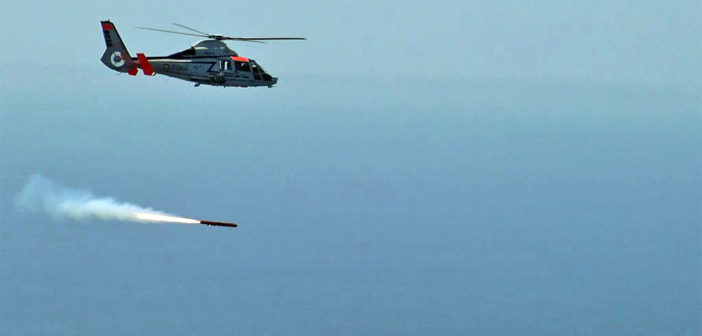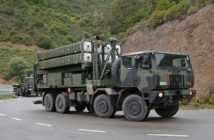Paris, France, 30 June 2017 — MBDA’s Sea Venom / ANL anti-ship missile has successfully completed its first firing at the Île du Levant test range off the French Riviera.
Conducted this June, the first firing is a major milestone for the Anglo-French missile; developed to deliver an enhanced capability and replace existing and legacy systems such as the UK-developed Sea Skua and the French-developed AS15TT anti-ship missiles.
The trial of the 100 kg-class missile was conducted from a Dauphin test bed helicopter owned by the DGA (Direction Générale de l’Armement – the French defence procurement agency).
Frank Bastart, head of the Sea Venom/ANL programme at MBDA, said: “The missile trial was a complete success, and is a proud moment for the company and all those involved in the project. When it enters service Sea Venom/ANL will provide a major increase in capability to the French and UK armed forces.”
Jointly ordered in 2014, the Sea Venom/ANL project has been developed 50/50 between the UK and France and has played a key part in the creation of shared centres of excellence on missile technologies in both countries – a move that will provide significant benefits to both nations.
Paul Goodwin, deputy head of the Sea Venom project, added: “Although a first firing this was in no way a cautious one. The system was pushed to the very edge of its range capability – a bold step showing our confidence in the design maturity and making success all the more sweet. The next step is to exercise the systems’ operator-in-the-loop capabilities.”
In UK service the missile is planned to be used from the AW159 Wildcat helicopter, while France will operate the missile from its new Hélicoptère Interarmées Léger (HIL). The missile has been designed for use from the widest range of platforms, with air carriage trials having been conducted to demonstrate compatibility of the missile on legacy Lynx helicopters.
Sea Venom — not to be mistaken with the legacy de Havilland naval fighter of the 50s — is a modern primarily anti-ship missile designed to destroy vessels ranging from FIAC (Fast Inshore Attack Craft), through medium sized FAC (Fast Attack Craft) up to large vessels such as Corvettes from safe stand-off ranges. This missile also has a coastal suppression capability against land targets. Unlike legacy semi-active radar guided missiles, Sea Venom uses an imaging infrared seeker that offers ‘fire-and-forget’ capabilities in even the most complex littoral environments. The missile has 30 kg-class warhead and a range of around 20 km. It offers a variety of different flight profiles – including sea skimming – and can be salvo fired. The missile is the natural choice for militaries wishing to replace or enhance their rotary-wing anti-ship capabilities.
Sea Venom is major advance from a technological standpoint. This new system provides very precise effects against a wide range of threats, even in complex environments, thus satisfying a recognised and common future need. A high speed, two-way data-link communicates the images ‘seen’ by the missile’s infrared seeker to the operator, who, in addition to initiating an autonomous engagement, can alternatively remain in control of the missile throughout the full duration of its flight. This optional, operator-in-the-loop, monitor-and-control facility, enables new capabilities such as: in-flight re-targeting; final aim point correction and refinement; or safe abort.//


